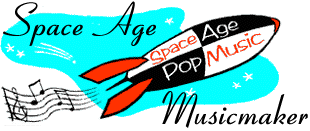Home · Listener's Guide · The Songs · Who's Who · Liner Notes · Selected Tracks · What's New · Search

Gershon Kingsley
- Born 28 October 1925, Bochum, Germany
In 1964, while staff arranger at Vanguard Records, Gershon Kingsley met Jean Jacques Perrey, and decided to collaborate on some recordings constructed almost entirely out of edited and manipulated prerecorded tape. Kingsley took a sample to Vanguard, then an innovating label specializing in folk, ethnic music, and the avant garde, and Vanguard contracted for a whole album. The result, The In Sound from Way Out! was an immediate hit--less in terms of popular sales than in terms of influence--and has gone on to become of the essential albums of space age pop.
Born to a German Jewish father and a Polish Catholic mother, Kingsley emigrated with his family to Israel in 1938, just before Kristallnacht. Following World War Two, he travelled to New York City to try to get into Juilliard, but he was rejected for not having graduated from a secondary school. Instead, he moved to California to join an older brother, and earned his way through night school and the Los Angeles Conservatory of Music by performing as an accompanist.
After his graduation from the Conservatory, Kingsley had to scrape along as a professional musician, taking whatever jobs came along. "I was a musical whore," he told V. Vale in his interview in Incredibly Stange Music Vol.1, "I did everything to survive." Eventually, Kingsley moved to New York City in the mid-1950s, and got a job working for producer David Merrick as musical director on "The Entertainer," a John Osborne play starring Laurence Olivier. A few years later, he began working for Vanguard, for whom he arranged albums of Greek, French, and Israeli folk songs.
Perrey's experimentation with musical assemblages constructed from prerecorded sounds edited into musical "notes" inspired Kinsgley, who was interested in the relationship between music and humor and saw a chance to pull the two together. One he embarked on the project with Perrey, it was slow and tedious work: "It was both fun and painful because each piece took a solid week of tape splices to prepare." It was almost a year after the pair started that the album was finally released in 1966.
The album sold well by Vanguard's modest standards, but far beyond its sales was its influence. Ad agencies were the first to recognize the potentials of this new music of bloops, bleeps, and blips, and several cuts were used in television and radio commercials. Ad jingles would eventually become a steady income source for both men, and one of their earliest compositions, "The Savers," for No-Cal diet drinks, won a Clio award in 1968. But perhaps the most memorable use of Perrey and Kingsley's music was Disney's incorporation of "Baroque Hoedown" into the nightly Main Street Electrical Parade at Disneyland and Walt Disney World.
Perrey had become acquainted with Robert Moog, who was just then beginning to manufacture the electronic synthesizer bearing his name. For their second album, they brought in a Moog synthesizer, which Perrey played (along with the Ondioline) while listening to a playback of Kingsley's arrangements. Kaleidoscopic Vibrations was susbtitled, in fact, "Spotlight on the Moog," and represented the first major recording to feature the Moog.
Perrey and Kingsley went separate if similar ways after that. Kingsley continued to experiment with the Moog, recording two Moog albums for Audio Fidelity. Impresario Sol Hurok, fascinated by Kingsley's work, hired him to lead a Moog quartet at Carnegie Hall in early 1970.
There were two catches, however. First, Kingsley had to convince Robert Moog to build the three other synthesizers he needed. Then he had to hire and train four musicians to play them. He ended up auditioning 150 players to find the four he needed, and the group's initial performance drew a range of responses, from an outright slam by The New York Times to an enthusiastic call from Arthur Fiedler. Fiedler asked Kingsley to write a Concerto for Moog that the quartet performed with the Boston Pops Orchestra in 1971.
The most lasting impact from the quartet's work was perky little number, "Popcorn," that Kingsley claims took all of about two minutes to write. Covered by a German group, Hot Butter, "Popcorn" became an international hit, one of the few instrumentals of the 1970s to break the Top 20 in the U.S. and elsewhere. "It sent my daughter through the university," commented Kingsley. Kingsley tried to follow up on its success with several other numbers, including "Cold Duck" and "Sauerkraut," but "Popcorn" was destined to remain the only major hit to spotlight the Moog.
Kingsley took a variety of arranging and composing jobs after that, continuing to experiment with the Moog and other musical technology. He wrote several film scores, mostly for B-grade sex and horror movies such as "Silent Night, Bloody Night," "Sugar Cookies," and "Death House 1981." More importantly, he composed the first rock-influenced piece to be performed in a synagogue, "Shabbat for Today, God, and Abraham," in 1969, and the work went on to be performed all over the world.
He continues to work, writing and performing with the aid of a Kurzweil and sells CDs of his work direct to the public.
To learn (and hear) more about Gershon Kingsley, check out his website at http://www.kingsleysound.com/title.html.
Recordings
- The In Sound From Way Out!, Vanguard VSD-79222
- Kaleidoscopic Variations, Vanguard VSD-6525
- The Essential Perrey & Kingsley, Vanguard VSD-71/72
- Music to Moog By, Audio Fidelity AFS-6226
- Popcorn--the First Moog Quartet, Audio Fidelity AFS-6254
- Switched-On Gershwin, AVCO 11004-598
S p a c e A g e P o p M u s i c
Home · Listener's Guide · The Songs · Who's Who · Liner Notes · Selected Tracks · What's New · Search
Email: editor@spaceagepop.com